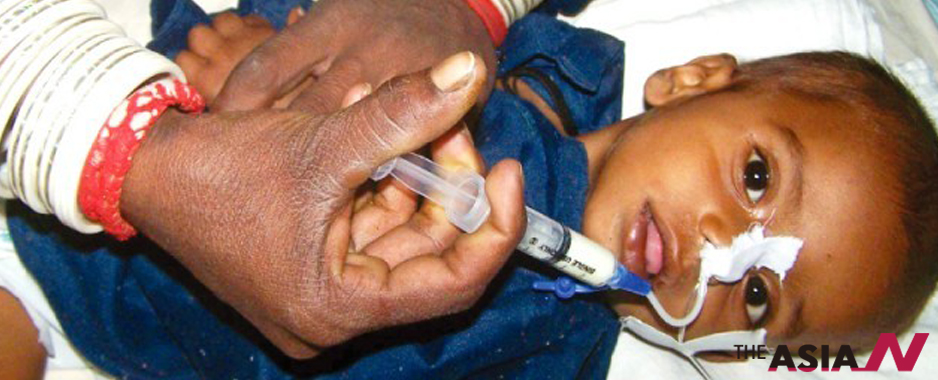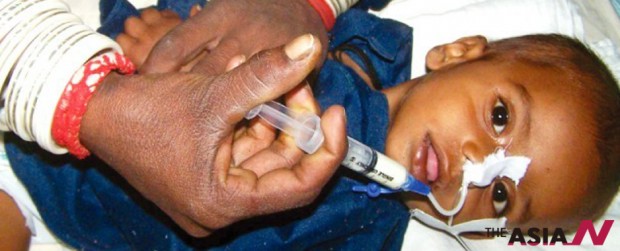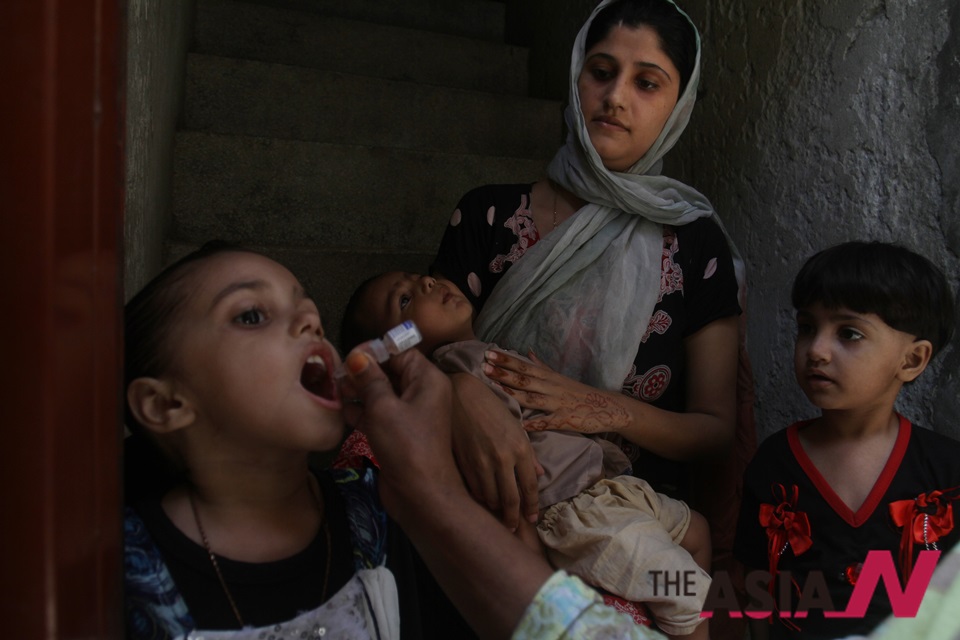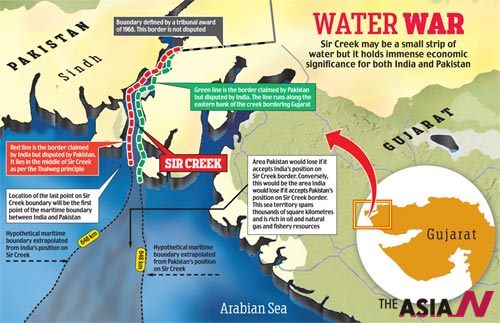
Drought and famine cause death of scores of children every year in Pakistan’s Thar Desert
The persistent drought spell, compounded by poverty, poor nutrition and lack of health facilities and awareness, continues to take its toll on the children of Tharparkar, the desert district of southern Sindh province of Pakistan bordering India. Around 140 children have reportedly expired and over 200 admitted to local hospitals during last two months while serious cases are referred to bigger hospitals in other cities.
“About fifty ailing children are brought daily to the hospitals from remote villages of desert,” Nand Lal, a journalist based at Mithi, the district headquarters town of Tharparkar, told Magazine N on telephone. There are over 2300 small villages across the district.
“The desert womenfolk, faced with abject poverty and malnutrition, give birth to feeble babies prone to various diseases like pneumonia, septicemia, birth asphyxia, diarrhea, hemorrhagic fever and Sepsis that prove fatal for them,” he told quoting the medical teams engaged in emergency relief work.
The drought and famines are nothing new for the people of Thar Desert, as none of the successive governments at federal as well as provincial level has taken measures for sustainable development ensuring provision of potable water, sanitation, healthcare and other basic facilities to 1.5 million population of district since inception of country in 1947. The Thari people (inhabitants of Thar Desert) and their livestock depend on rains. Using the rain-harvesting local techniques, they store water in ponds and the same impure water is consumed both by humans and animals. They also get water from wells using the donkeys and camels to pull the rubber bucket, tied with long ropes, drawing water from 100ft depth. “Due to scanty rains for two consecutive years the water level of the wells has fallen further and the water has now turned brackish,” Nand Lal told.
The rains are also the major source of their livelihood, as they cultivate crops and store the food for next few months. In case of no or scanty rains the Thari people migrate to other areas in search of labor. However, a large number of them does not leave their ancestral abodes and fall prey to famine. Approximately 175,000 families have migrated from the remote areas of Thar to other areas of Sindh for their survival. But according to government leaders the migration is routine annual feature.
After killing the livestock, birds and animals – peacocks, cows, sheep, parrots, deer, camels and goats of these people this ghost has turned its evil eye towards Thari people and has claimed the lives of 140 children within two months. Earlier this year in January and February too over two dozen deaths of children were reported. “As many as 500 deaths have occurred since last year,” Khatao Jani, another journalist based in Mithi and representing a largest circulated Sindhi language newspaper, told.
“Drought in the desert areas is natural but the death of people is not the natural. It is due to lack of facilities and irresponsibility of people sitting at the helms of affairs,” Dr. Khataomal, a notable of the area and a social worker, remarked when asked to comment on the situation.
The local media is full of criticism on government for giving lame excuses and statements in order to escape responsibility of ‘criminal acts.’ The media censured even the Chief Minister of Sindh Province when he dispelled the reports saying deaths are not due to drought or malnutrition. On another occasion he said deaths of children being reported in Tharparkar are largely on account of maternity related complications and not of hunger or food.
The government always begin distribution of wheat free of cost or at discounted rates but according to media reports the Thari people could not benefit from charity, as the wheat stocks are often misappropriated by corrupt bureaucracy and the local leaders of ruling parties. The media is full of such allegations, which obviously are rejected by the government.
Meanwhile a Commissioner of that region was reported as saying that they had not distributed 60,000 bags of wheat among the Thari people living in remote areas because of lack of money for transportation.
The media termed it a shameful statement saying ‘in a country where millions of rupees are spent on mega festivals arranged by the ruling party, and the leaders go on official tours to other countries, the officials publicly admit that they have no money to transport vitally needed food rations.’
The drought did not just happen suddenly. These people have been facing such difficulties every year as evident from a report of the Commission consisting of retired judges to probe the negligence in handling the drought and famine.
The Commission, constituted in April last, had mentioned in its report that 234 deaths were caused due to famine and malnutrition by that time. It blamed Sindh provincial health department and elected representatives of the district.
The Commission also criticized the Provincial Disaster Management Authority’s role in dealing with the drought.
Members of the commission had visited Tharparkar several times and interviewed families of victims, doctors, health experts, elected representatives and civil servants.
The report says that the Thar region has historically been neglected by those in power.
Justice Alavi, a member of the Commission talking to media had said millions of rupees were given to parliamentarians of the region. “I don’t know where the money goes or when they will spend it on development, especially in health and education sectors.”
The inquiry report says that district health officers are supposed to be aware of the situation. Only one district hospital in Mithi cannot take care of residents of the entire district.
The report says that the death toll would not have been so high if residents were provided sufficient medical facilities in their areas of residence. Similarly, the drought could have been averted if the government had a comprehensive strategy to deal with it.
The report quotes residents of the area as saying many people die each year. The official death toll only takes count of people who died in Mithi Hospital, Tharparkar. As many as 439 people died in 2011, 588 in 2013, and 234 in 2014. This number has increased with 140 deaths occurred in last two months.
In his statement before the commission, Health Secretary Iqbal Durrani had said the plight of Tharparkar came to light in February while the Health Department had begun rehabilitating people. According to Secretary they had appointed 53 doctors at Mithi Hospital, of which only 20 had joined duties. He said most of the mothers gave birth to children on sand as a result of which the newborns developed infections of all sorts.
National Institute of Child and Health Care Hospital Director Jamal Raza, who visited Tharparkar to set up camps, told the Commission that while many among the children he had checked suffered from dysentery and skin infections, and chronic malnutrition was the most common ailment – even the mothers were malnourished.
The report calls for basic health centers and hospitals with doctors, safe water and adequate equipment.
It is worth mentioning that the government had built the rural health centers across the desert district but no doctor appointed for several years. About 200 posts of doctors are lying vacant at these health centers.
Surprisingly no international NGO has stepped in to help the starved people and the ailing children of Thar Desert. Currently the Pakistan Army, a number of Pakistani NGOs, government organizations, philanthropists etc have setup relief camps and providing medical healthcare facilities to the people. The government claims distributing wheat bags free of cost while a business tycoon/builder has established centers for provision of free cooked food to Thari people. But the people frequently ask a question: What will happen when all these organizations and philanthropists will go back? Same situation would emerge again. The solution of the drought and famine is sustainable development that would ensure water, sanitation, healthcare, education and above all employment opportunities. The Tharparkar district is rich in natural resources like China clay, granite, some other minerals and above all largest coal reserves of country that would help establish industries and ensure job opportunities to the starving people.











